An Optimal Scheduling Method for Multi-Energy Hub Systems Using Game Theory
Abstract
1. Introduction
2. The Optimal Scheduling Model of Multi-Energy Hub Systems
2.1. Internal Coupling Model of the Energy Hub
2.2. Transmission Network Model among Energy Hubs
3. Game Theoretic Optimal Scheduling Method for the Multi-Energy Hub System
3.1. Equations of the Game Theoretic Optimal Scheduling Model Among Multi-Energy Hubs
3.2. Solution of the Game Theoretic Optimal Scheduling Model
4. Case Studies
4.1. Game Theoretic Optimal Scheduling Model of the System
4.2. Optimal Scheduling Solution
4.2.1. Case 1: Optimal Scheduling Solution of System Load and Wind Power Input without Considering Seasonal Variation
4.2.2. Case 2: Optimal Scheduling Solution of the System When Considering Seasonal Variation
4.3. Effect of Uncertainty of Wind Power on the Equilibrium Solution
4.3.1. Case 1: Effect of Variation of Wind Speed Series Subjected to Weibull Distribution on the Equilibrium Solution without Considering Seasonal Variation
4.3.2. Case 2: Effect of Wind Speed Series Change on the Equilibrium Solution When Considering Seasonal Variation
5. Conclusions
Author Contributions
Funding
Conflicts of Interest
References
- Heussen, K.; Koch, S.; Ulbig, A.; Andersson, G. Unified systemlevel modeling of intermittent renewable energy sources and energy storage for power system operation. IEEE Syst. J. 2012, 6, 140–151. [Google Scholar] [CrossRef]
- Orehounig, K.; Evins, R.; Dorer, V. Integration of decentralized energy systems in neighbourhoods using the energy hub approach. Appl. Energy 2015, 154, 277–289. [Google Scholar] [CrossRef]
- Zhang, X.; Shahidehpour, M.; Alabdulwahab, A.; Abusorrah, A. Optimal expansion planning of energy hub with multiple energy infrastructures. IEEE Trans. Smart Grid 2015, 6, 2302–2311. [Google Scholar] [CrossRef]
- Evins, R.; Orehounig, K.; Dorer, V.; Carmeliet, J. New formulations of the ‘energy hub’ model to address operational constraints. Energy 2014, 73, 387–398. [Google Scholar] [CrossRef]
- Dolatabadi, A.; Mohammadi-ivatloo, B.; Abapour, M.; Tohidi, S. Optimal Stochastic Design of Wind Integrated Energy Hub. IEEE Trans. Ind. Inform. 2017, 13, 2379–2388. [Google Scholar] [CrossRef]
- Brahman, F.; Honarmand, M.; Jadid, S. Optimal electrical and thermal energy management of a residential energy hub, integrating demand response and energy storage system. Energy Build. 2015, 90, 65–75. [Google Scholar] [CrossRef]
- Rastegar, M.; Fotuhi-Firuzabad, M.; Lehtonen, M. Home load management in a residential energy hub. Electr. Power Syst. Res. 2015, 119, 322–328. [Google Scholar] [CrossRef]
- Martinez-Mares, A.; Fuerte-Esquivel, C.R. A Unified Gas and Power Flow Analysis in Natural Gas and Electricity Coupled Networks. IEEE Trans. Power Syst. 2012, 27, 2156–2166. [Google Scholar] [CrossRef]
- Liu, X.; Wu, J.; Jenkins, N.; Bagdanavicius, A. Combined analysis of electricity and heat networks. Appl. Energy 2016, 162, 1238–1250. [Google Scholar] [CrossRef]
- Liu, X.; Mancarella, P. Modelling, assessment and Sankey diagrams of integrated electricity-heat-gas networks in multi-vector district energy systems. Appl. Energy 2016, 167, 336–352. [Google Scholar] [CrossRef]
- Wang, Y.; Zhang, N.; Zhuo, Z.; Kang, C.; Kirschen, D. Mixed-integer linear programming-based optimal configuration planning for energy hub: Starting from scratch. Appl. Energy 2018, 210, 1141–1150. [Google Scholar] [CrossRef]
- He, Y.; Shahidehpour, M.; Li, Z.; Guo, C.; Zhu, B. Robust constrained operation of integrated electricity-natural gas system considering distributed natural gas storage. IEEE Trans. Sustain. Energy 2018, 9, 1061–1071. [Google Scholar] [CrossRef]
- Davatgaran, V.; Saniei, M.; Mortazavi, S.S. Optimal bidding strategy for an energy hub in energy market. Energy 2018, 148, 482–493. [Google Scholar] [CrossRef]
- Alipour, M.; Zare, K.; Abapour, M. MINLP probabilistic scheduling model for demand response programs integrated energy hubs. IEEE Trans. Ind. Inform. 2018, 14, 79–88. [Google Scholar] [CrossRef]
- Thomas, D.; Deblecker, O.; Ioakimidis, C.S. Optimal operation of an energy management system for a grid-connected smart building considering photovoltaics’ uncertainty and stochastic electric vehicles’ driving schedule. Appl. Energy 2018, 210, 1188–1206. [Google Scholar] [CrossRef]
- Fu, X.; Huang, S.; Li, R.; Sun, H. Electric power output optimization for CCHP using PSO theory. Energy Procedia 2016, 103, 9–14. [Google Scholar] [CrossRef]
- Jin, X.; Mu, Y.; Jia, H.; Wu, J.; Xu, X.; Yu, X. Optimal day-ahead scheduling of integrated urban energy systems. Appl. Energy 2016, 180, 1–13. [Google Scholar] [CrossRef]
- Huang, Y.; Wang, L.; Guo, W.; Kang, Q.; Wu, Q. Chance constrained optimization in a home energy management system. IEEE Trans. Smart Grid 2018, 9, 252–260. [Google Scholar] [CrossRef]
- Dolatabadi, A.; Jadidbonab, M.; Mohammadi-ivatloo, B. Short-term scheduling strategy for wind-based energy hub: A hybrid stochastic/IGDT approach. IEEE Trans. Sustain. Energy 2019, 10, 438–448. [Google Scholar] [CrossRef]
- Perera, A.T.D.; Nik, V.M.; Mauree, D.; Scartezzini, J.L. An integrated approach to design site specific distributed electrical hubs combining optimization, multi-criterion assessment and decision making. Energy 2017, 134, 103–120. [Google Scholar] [CrossRef]
- Cheng, M.X.; Crow, M.; Ye, Q. A game theory approach to vulnerability analysis: Integrating power flows with topological analysis. Int. J. Electr. Power Energy Syst. 2016, 82, 29–36. [Google Scholar] [CrossRef]
- Wang, Y.; Ai, X.; Tan, Z.; Yan, L.; Liu, S. Interactive dispatch modes and bidding strategy of multiple virtual power plants based on demand response and game theory. IEEE Trans. Smart Grid 2016, 7, 510–519. [Google Scholar] [CrossRef]
- Wu, Q.; Ren, H.; Gao, W.; Ren, J.; Lao, C. Profit allocation analysis among the distributed energy network participants based on Game-theory. Energy 2017, 118, 783–794. [Google Scholar] [CrossRef]
- Liu, J.; He, D. Profit allocation of hybrid power system planning in energy internet: A cooperative game study. Sustainability 2018, 10, 388. [Google Scholar] [CrossRef]
- Gao, B.; Liu, X.; Chen, C.; Li, Y. Economic optimization for distributed energy network with cooperative game. J. Renew. Sustain. Energy 2018, 10, 055101. [Google Scholar] [CrossRef]
- Han, L.; Morstyn, T.; McCulloch, M. Incentivizing Prosumer Coalitions with Energy Management using Cooperative Game Theory. IEEE Trans. Power Syst. 2019, 34, 303–313. [Google Scholar] [CrossRef]
- Liu, N.; Cheng, M.; Yu, X.; Zhong, J.; Lei, J. Energy Sharing Provider for PV Prosumer Clusters: A Hybrid Approach using Stochastic Programming and Stackelberg Game. IEEE Trans. Ind. Electron. 2018, 65, 6740–6750. [Google Scholar] [CrossRef]
- Geidl, M.; Koeppel, G.; Favre-Perrod, P.; Klockl, B.; Andersson, G.; Frohlich, K. Energy hubs for the future. IEEE Power Energy Mag. 2007, 5, 24–30. [Google Scholar] [CrossRef]
- Geidl, M.; Andersson, G. A modeling and optimization approach for multiple energy carrier power flow. In Proceedings of the 2005 IEEE Russia Power Tech, Saint Petersburg, Russia, 27–30 June 2005; pp. 1–7. [Google Scholar]
- Xu, X.Z.; Shan, D.; Wang, G.Y.; Jiang, X.Y. Multimodal medical image fusion using PCNN optimized by the QPSO algorithm. Appl. Soft Comput. 2016, 46, 588–595. [Google Scholar] [CrossRef]
- Moeini-Aghtaie, M.; Dehghanian, P.; Fotuhi-Firuzabad, M.; Abbaspour, A. Multiagent genetic algorithm: An online probabilistic view on economic dispatch of energy hubs constrained by wind availability. IEEE Trans. Sustain. Energy 2014, 5, 699–708. [Google Scholar] [CrossRef]
- Pazouki, S.; Haghifam, M.R. Optimal planning and scheduling of energy hub in presence of wind, storage and demand response under uncertainty. Int. J. Electr. Power Energy Syst. 2016, 80, 219–239. [Google Scholar] [CrossRef]
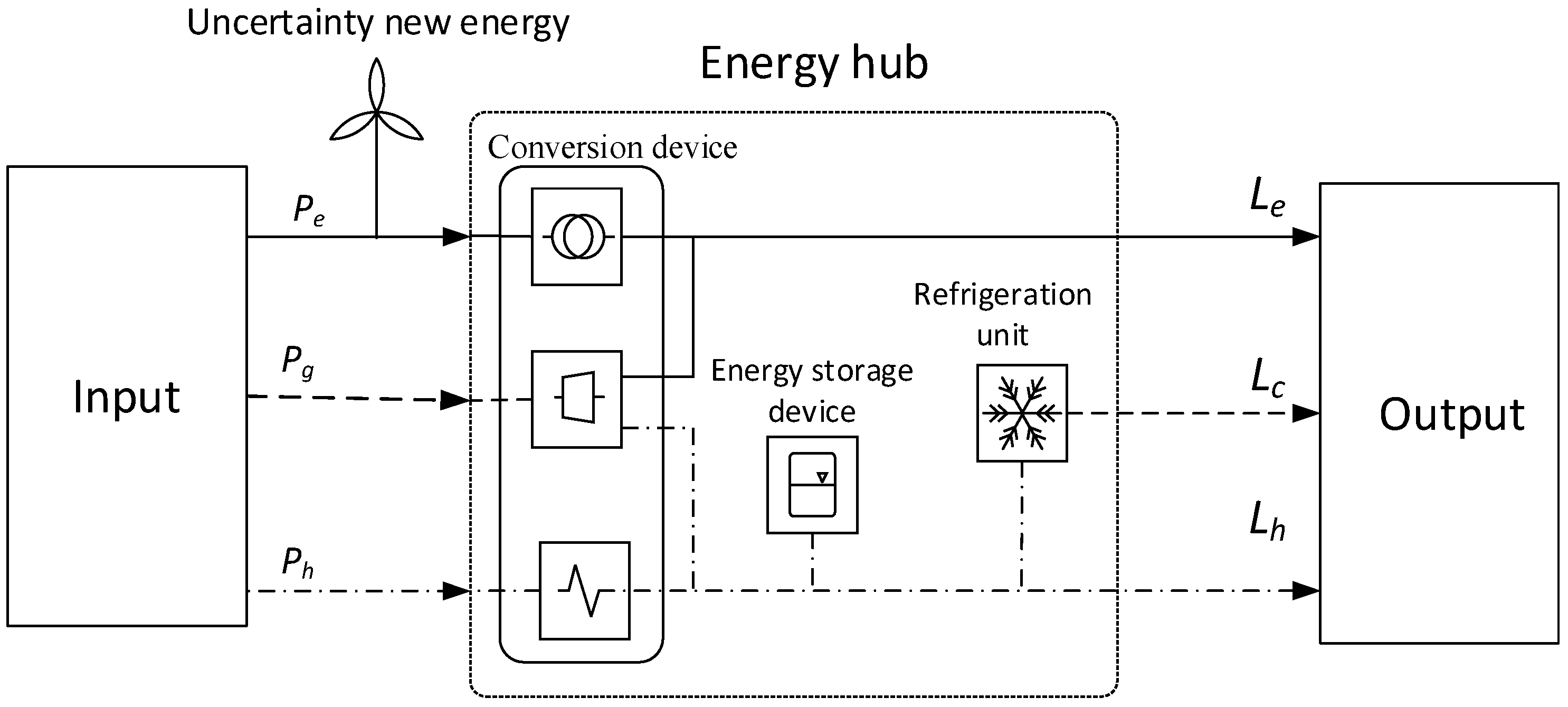
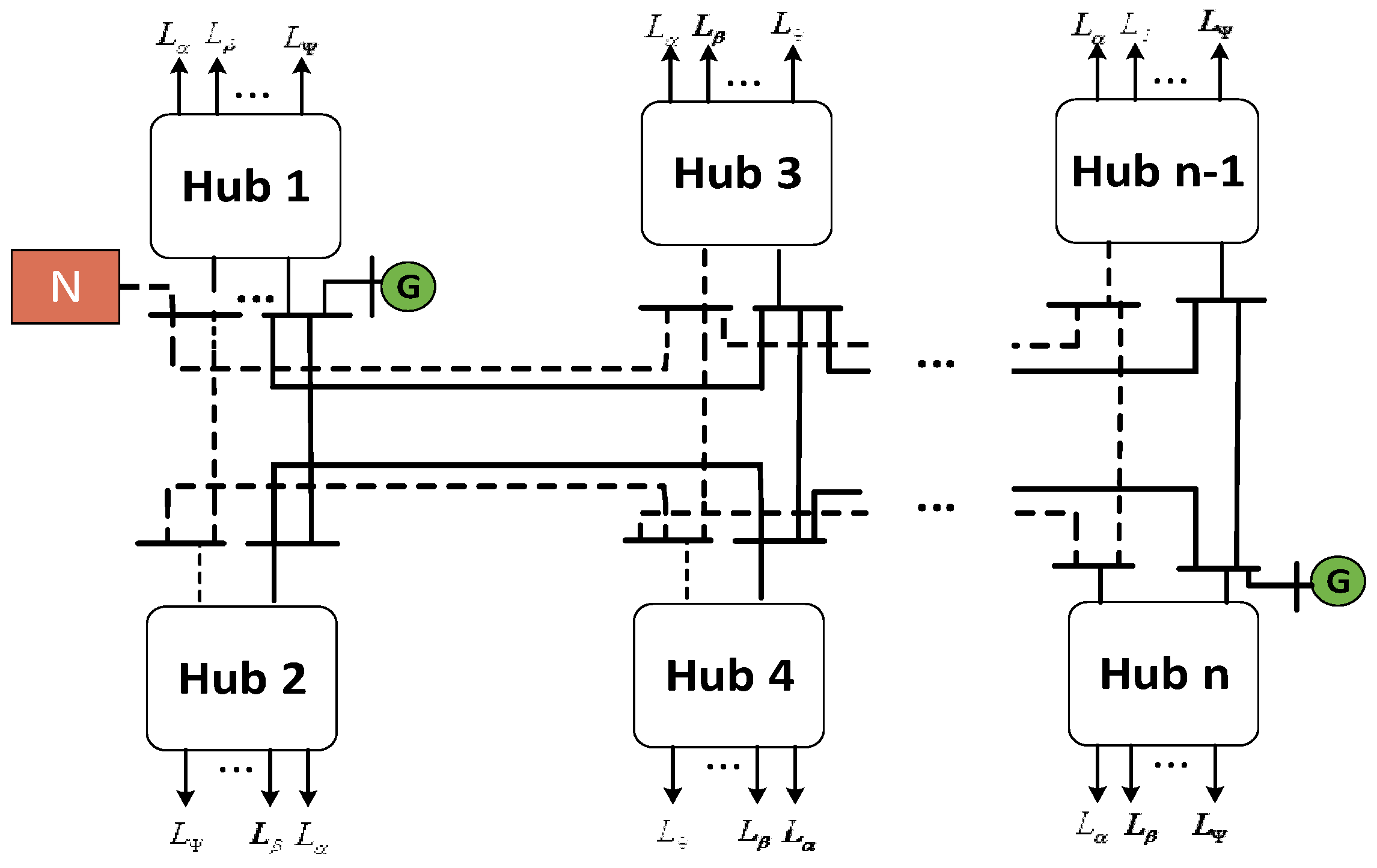


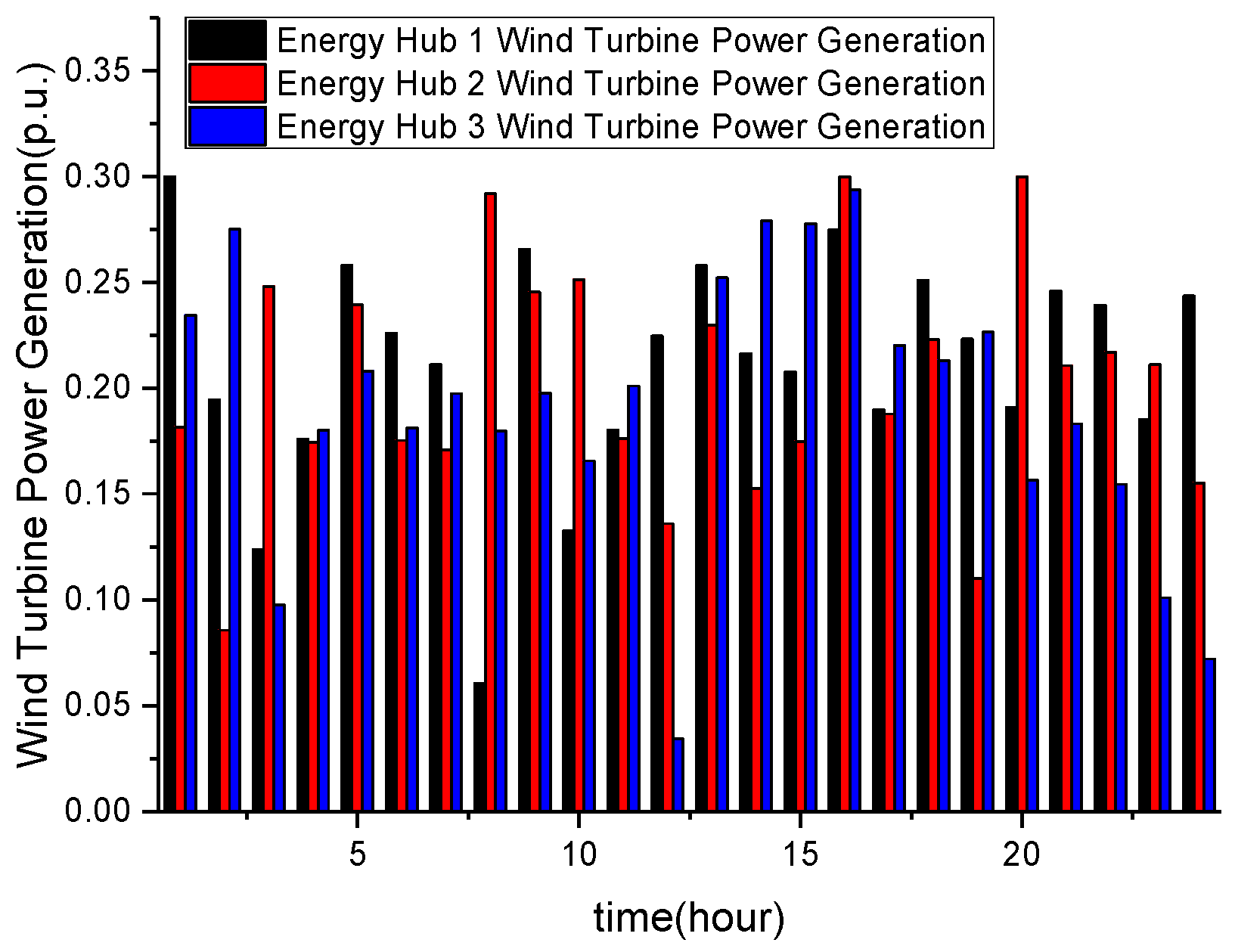
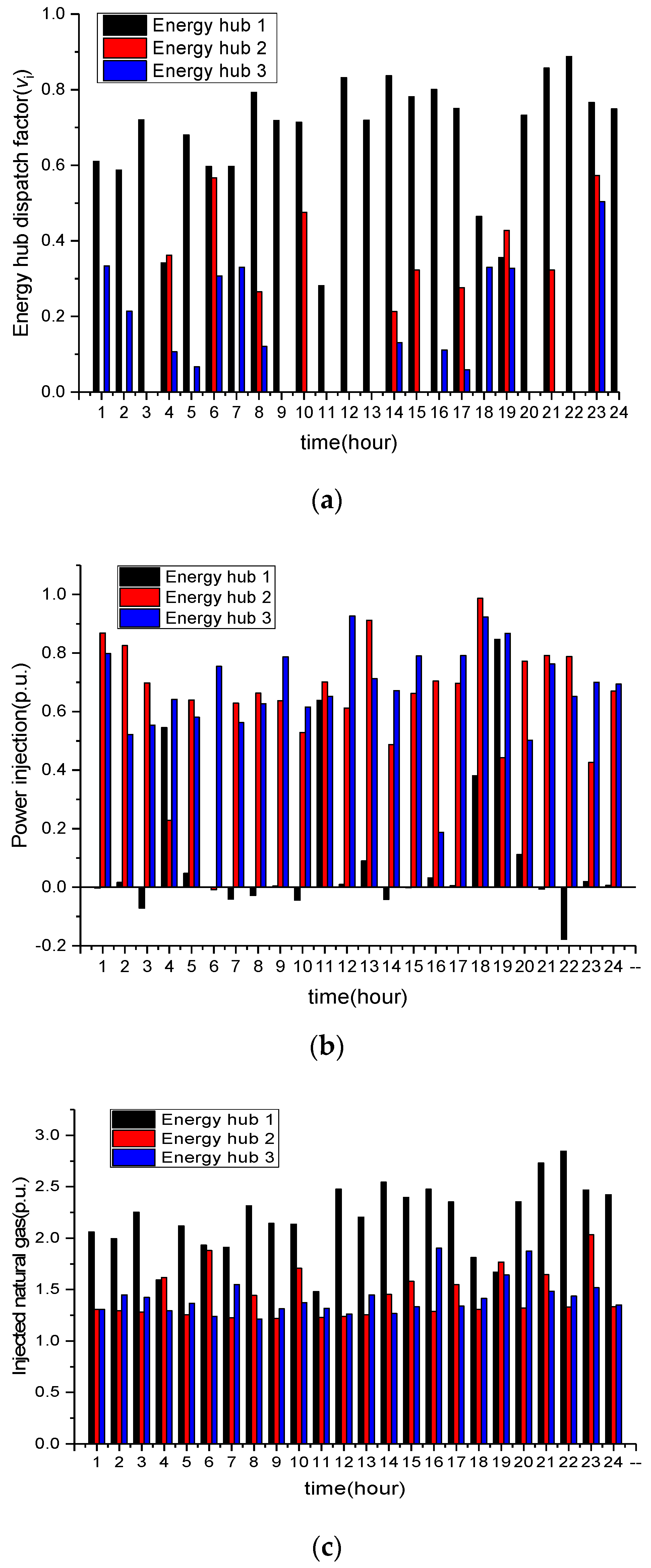
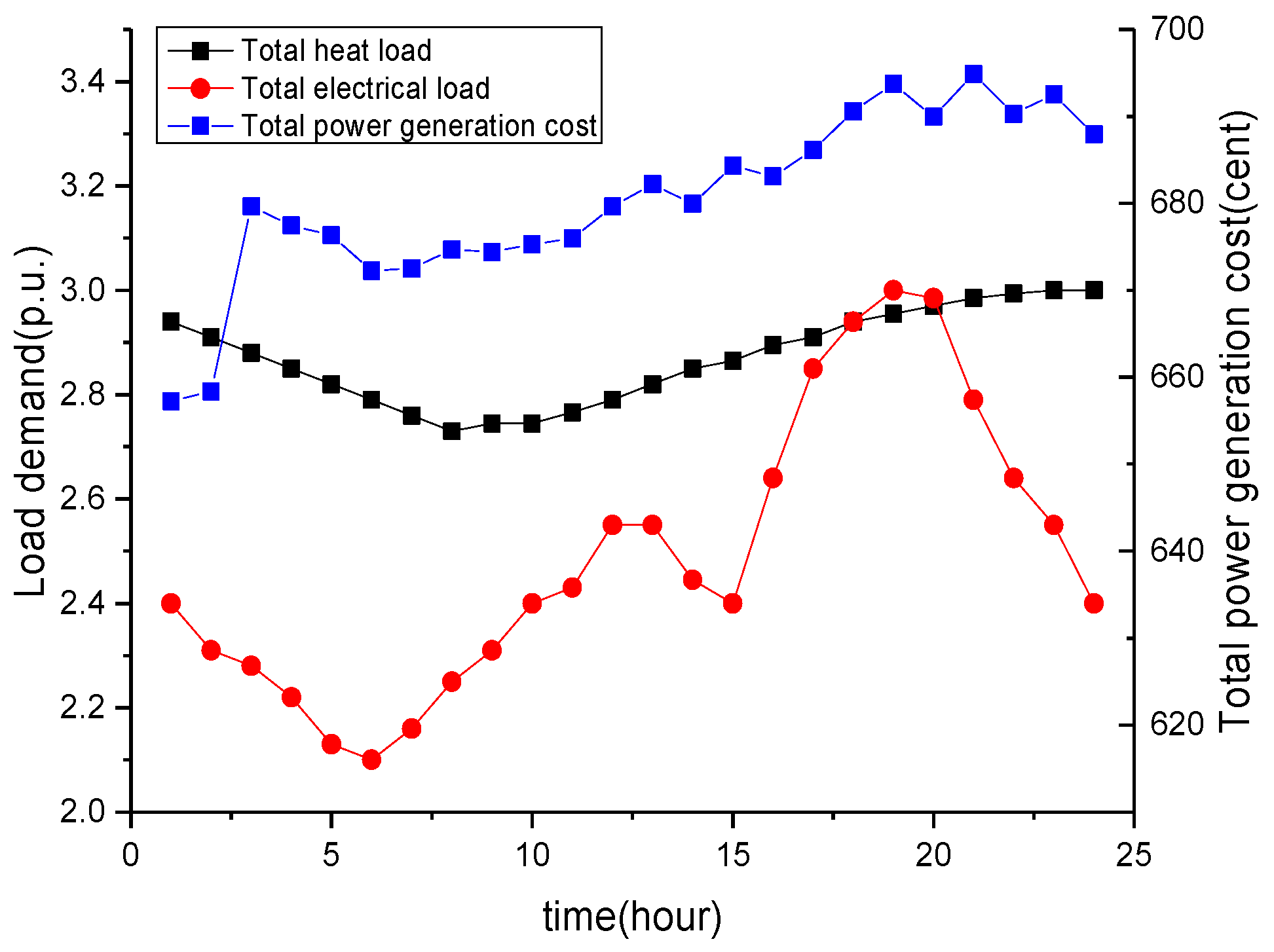
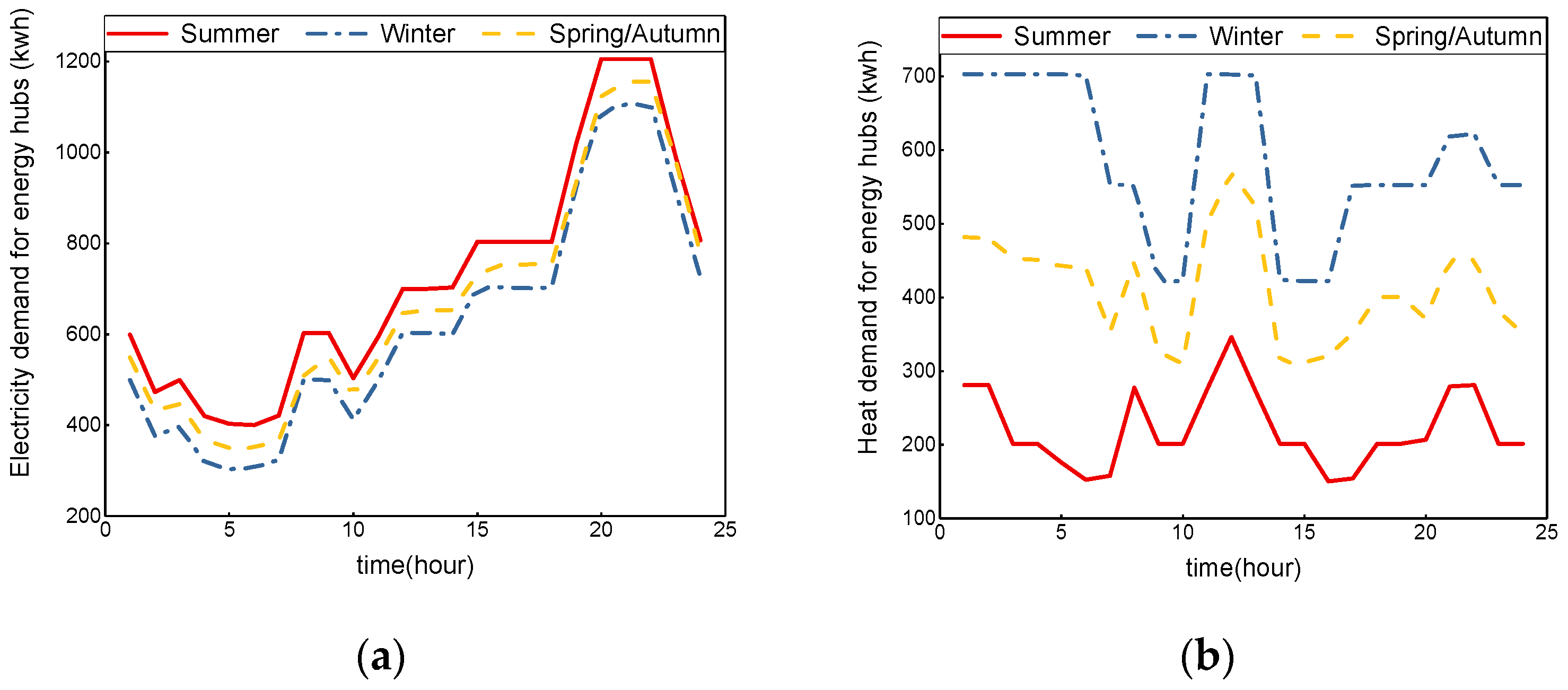

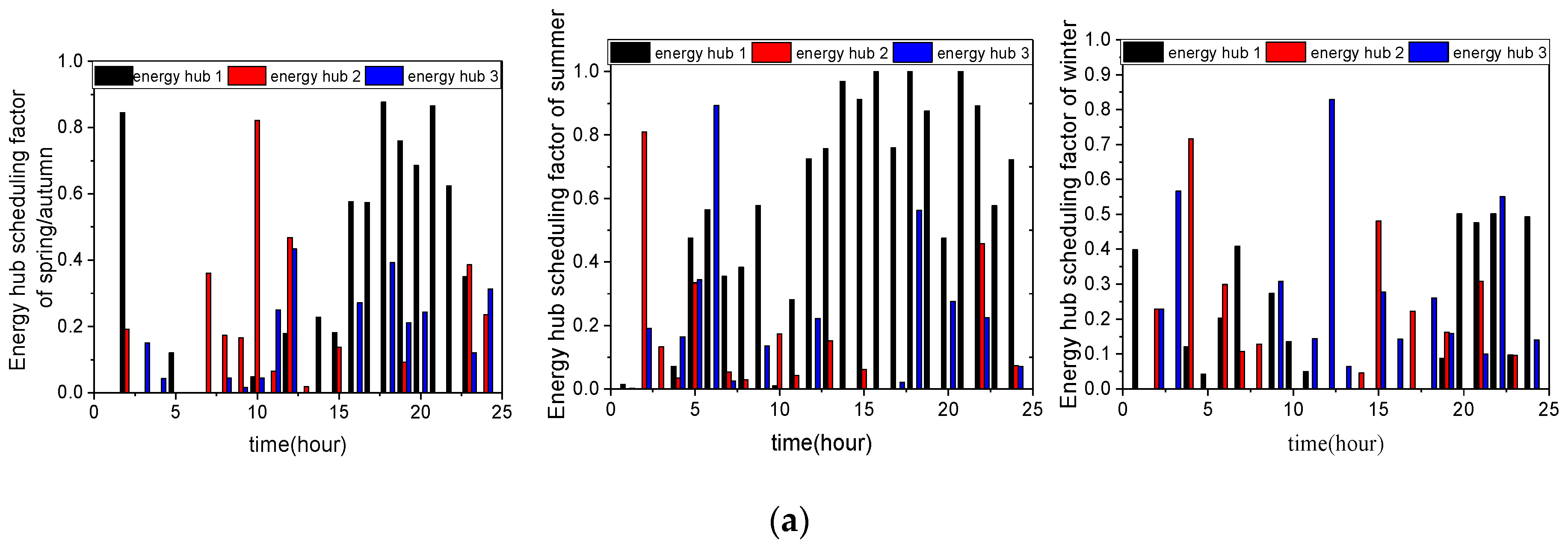
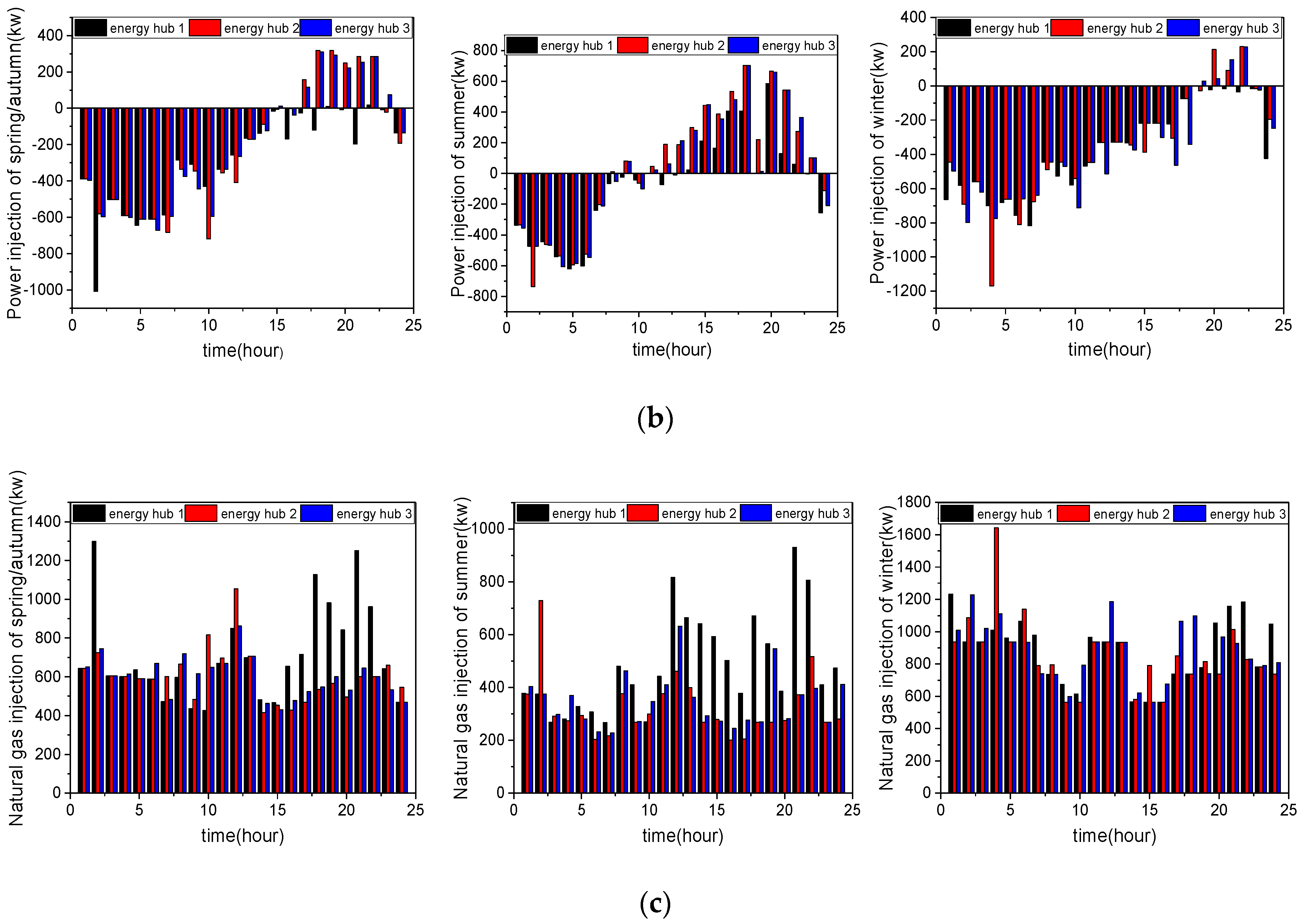
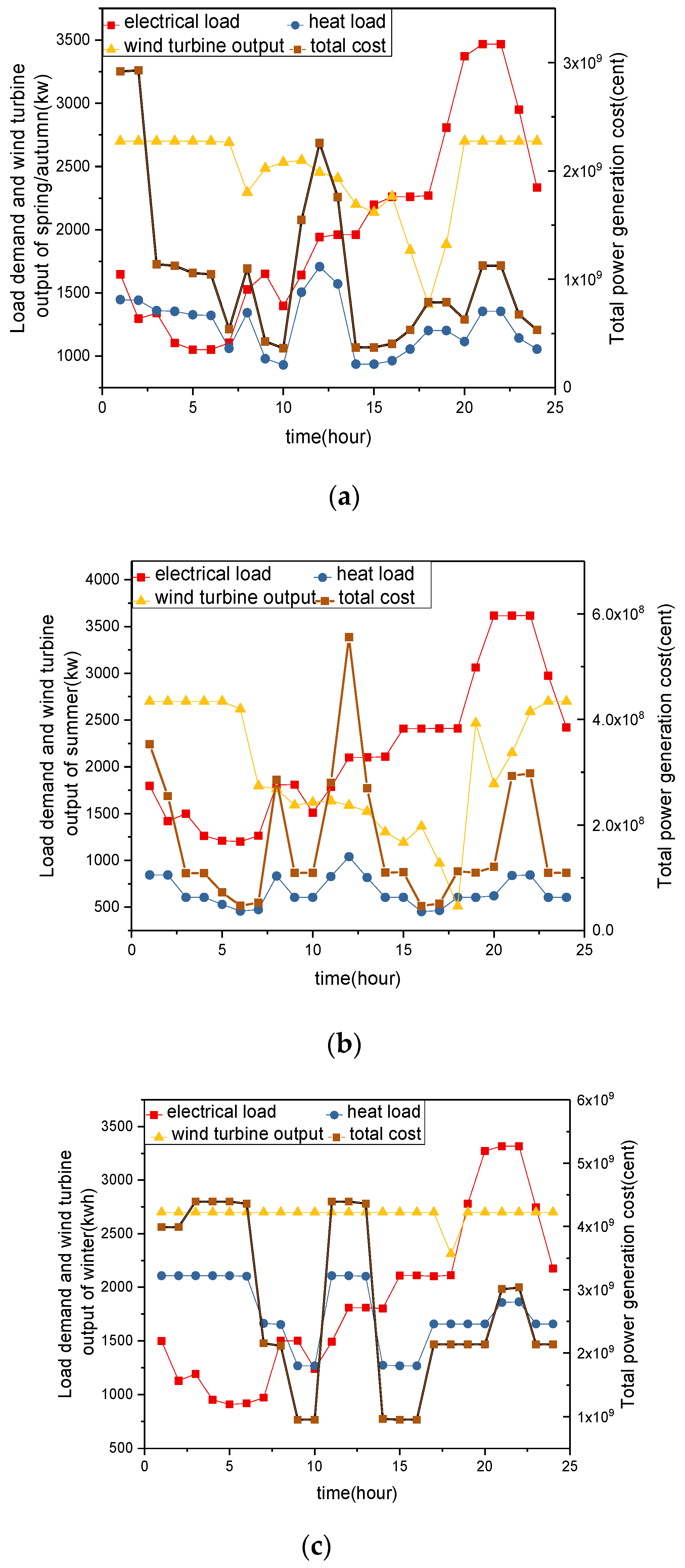

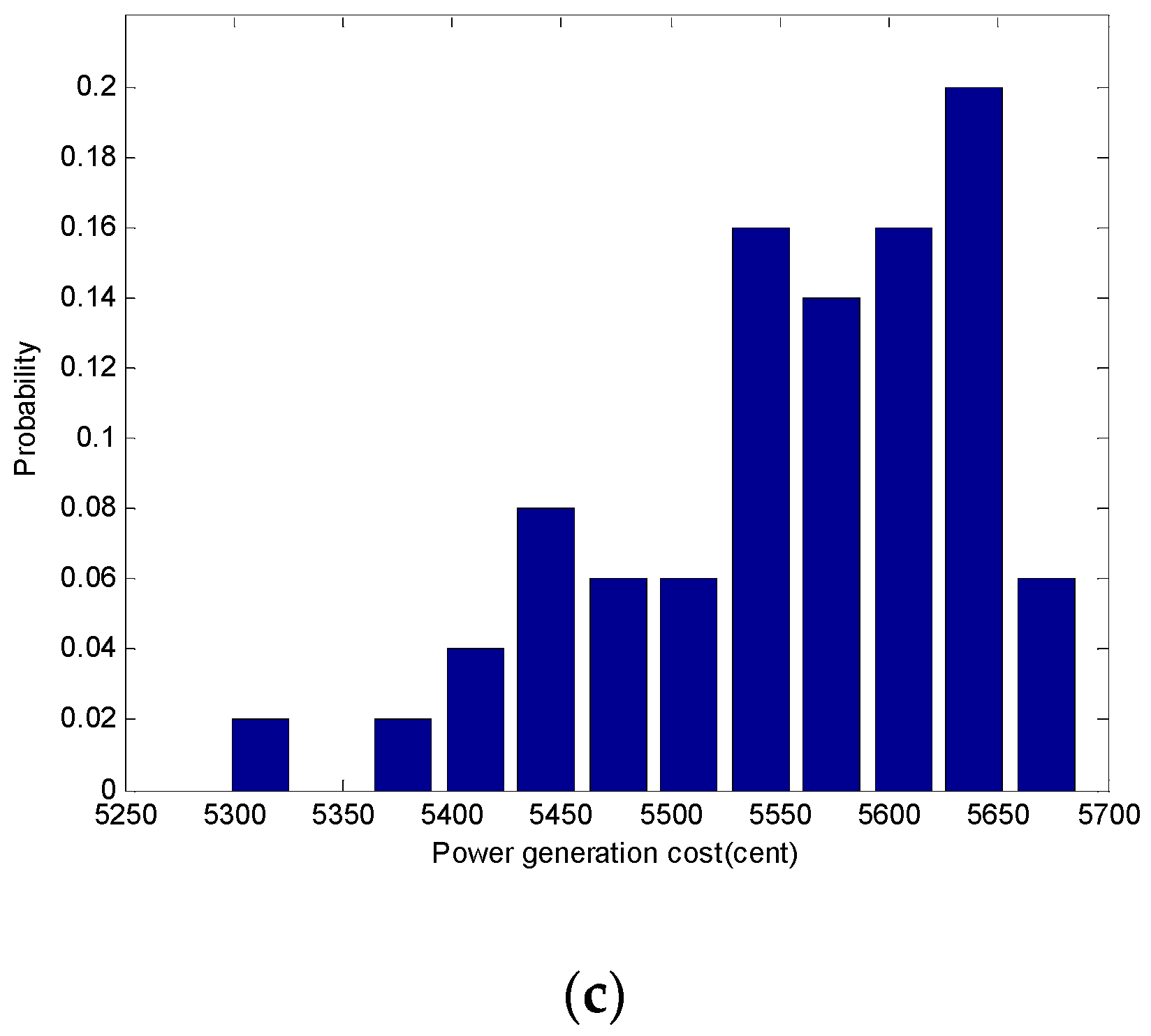

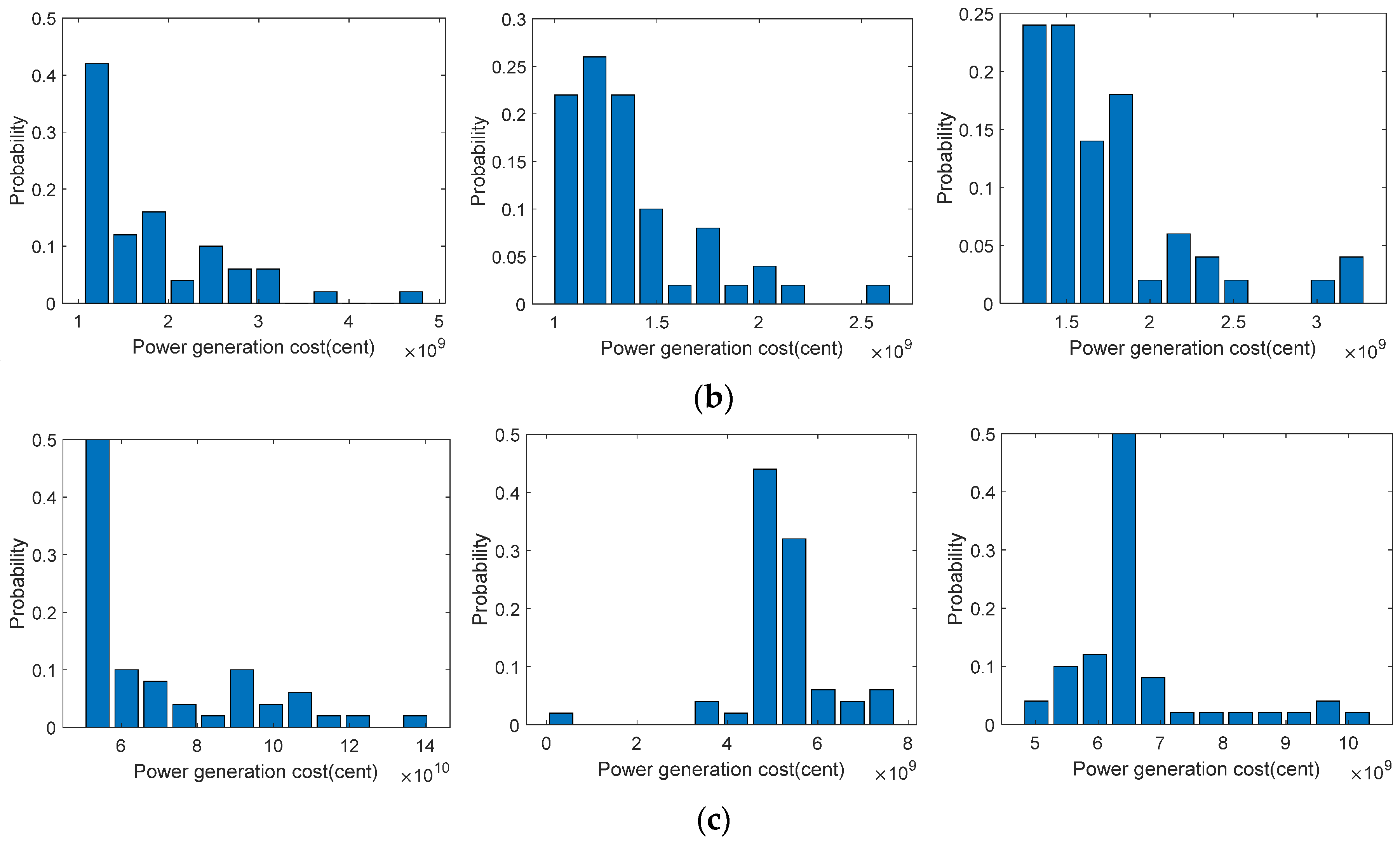
| 1: Give relevant parameters of multi-energy hub system , ,,,. 2: Establish cooperative game model for multi-energy hub system. Randomly select equilibrium point initial value . 3: Repeat. 4: Energy hubs make independent optimal decision in turn. ⋮ 5: Communicate with other participants in the multi-energy hub system about own optimal information. 6: 7: Until . |
| Input Carrier | aα (cent/pu) | bα(cent/pu) | cα(cent/pu) |
|---|---|---|---|
| Electricity(e) | 100 | 10 | −5 |
| Gas(g) | 100 | 5 | −2.5 |
| Line from-to | Length lj in pu | fie | fig |
|---|---|---|---|
| 1-2 | 6 | 0.02 | |
| 1-3 | 4 | 0.02 | |
| 2-3 | 3 | 10 |
© 2019 by the authors. Licensee MDPI, Basel, Switzerland. This article is an open access article distributed under the terms and conditions of the Creative Commons Attribution (CC BY) license (http://creativecommons.org/licenses/by/4.0/).
Share and Cite
Huang, Y.; Zhang, W.; Yang, K.; Hou, W.; Huang, Y. An Optimal Scheduling Method for Multi-Energy Hub Systems Using Game Theory. Energies 2019, 12, 2270. https://doi.org/10.3390/en12122270
Huang Y, Zhang W, Yang K, Hou W, Huang Y. An Optimal Scheduling Method for Multi-Energy Hub Systems Using Game Theory. Energies. 2019; 12(12):2270. https://doi.org/10.3390/en12122270
Chicago/Turabian StyleHuang, Yu, Weiting Zhang, Kai Yang, Weizhen Hou, and Yiran Huang. 2019. "An Optimal Scheduling Method for Multi-Energy Hub Systems Using Game Theory" Energies 12, no. 12: 2270. https://doi.org/10.3390/en12122270
APA StyleHuang, Y., Zhang, W., Yang, K., Hou, W., & Huang, Y. (2019). An Optimal Scheduling Method for Multi-Energy Hub Systems Using Game Theory. Energies, 12(12), 2270. https://doi.org/10.3390/en12122270





